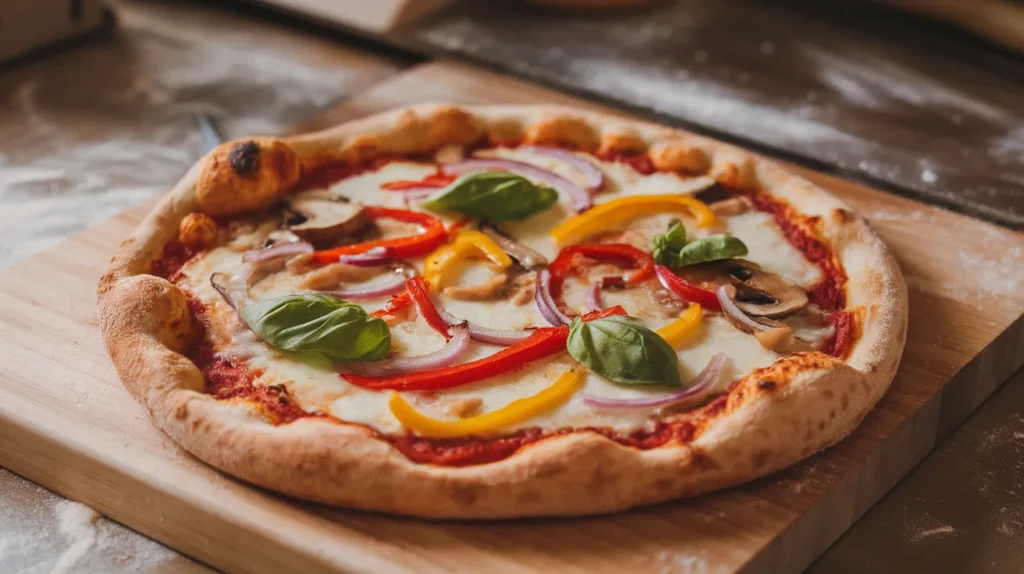This vegan pizza recipe transforms your kitchen into a pizzeria with simple, plant-based ingredients that create an absolutely delicious meal. Our beginner-friendly vegan pizza guide walks you through every single step, from mixing the perfect dough to achieving that golden, bubbly cheese topping that rivals any traditional pizza. Even if you’ve never made pizza from scratch, this detailed recipe ensures your first vegan pizza will be a complete success.
Recipe Info Bar
SERVES: 4 | PREP: 20 MIN | COOK: 25 MIN | TOTAL: 45 MIN
Ingredients
For the Vegan Pizza Dough
| Ingredient | Amount |
|---|---|
| Warm water (110°F) | 1 cup |
| Active dry yeast | 1 packet (2¼ tsp) |
| Sugar | 1 tsp |
| All-purpose flour | 3 cups |
| Olive oil | 2 tbsp |
| Salt | 1 tsp |
For the Sauce & Toppings
| Ingredient | Amount |
|---|---|
| Pizza sauce | ¾ cup |
| Vegan mozzarella cheese (shredded) | 1½ cups |
| Bell peppers (sliced) | 1 medium |
| Red onion (thinly sliced) | ½ medium |
| Mushrooms (sliced) | 8 oz |
| Fresh basil leaves | ¼ cup |
| Olive oil for drizzling | 2 tbsp |
| Italian seasoning | 1 tsp |
| Garlic powder | ½ tsp |
Detailed Step-by-Step Vegan Pizza Instructions
Phase 1: Creating the Perfect Pizza Dough (20 minutes)
Step 1: Test Your Water Temperature Fill a measuring cup with 1 cup of warm water. The water should feel like a comfortable bath – warm but not hot enough to hurt your finger. If you have a thermometer, aim for 110°F. Water that’s too hot will kill the yeast, while cold water won’t activate it. If your water is too hot, let it cool for 2-3 minutes before proceeding.
Step 2: Activate the Yeast (Critical Step) Pour the warm water into a large mixing bowl. Add 1 packet of active dry yeast and 1 teaspoon of sugar. Stir gently with a spoon for 10 seconds just to combine. Don’t stir vigorously. Set a timer and wait 5-8 minutes. You’ll know the yeast is working when the surface becomes foamy and bubbly, almost like cappuccino foam. If nothing happens after 10 minutes, your yeast might be expired – start over with fresh yeast.
Step 3: Prepare Your Flour Mixture While waiting for the yeast, get a medium bowl and add 3 cups of all-purpose flour and 1 teaspoon of salt. Use a whisk or fork to mix them together thoroughly. This step is important because salt can kill yeast if they touch directly, so we mix the salt with flour first.
Step 4: Combine Wet and Dry Ingredients Once your yeast mixture is foamy, add 2 tablespoons of olive oil to the yeast bowl and stir once. Now slowly pour the flour mixture into the yeast bowl. Using a wooden spoon or your hands, stir everything together until it forms a shaggy, rough-looking dough. Don’t worry if it looks messy – this is normal. The dough will be sticky and uneven at this stage.
Step 5: Knead the Dough (Most Important Step) Lightly flour a clean countertop or cutting board. Dump the shaggy dough onto the floured surface. Now comes the kneading – this develops the gluten that makes your crust chewy and delicious. Push the dough away from you with the heel of your hand, then fold it back over itself and turn it 90 degrees. Repeat this motion for 8-10 minutes. The dough will gradually become smooth and elastic. If it sticks to your hands, add a little flour – but only a tablespoon at a time. When properly kneaded, the dough should spring back when poked gently with your finger.
Step 6: First Rise Rub a little olive oil inside a clean, large bowl. Place your kneaded dough in the bowl and turn it once so all sides are lightly oiled (this prevents sticking). Cover the bowl with a damp kitchen towel – not soaking wet, just damp. Place the bowl in a warm, draft-free spot like the top of your refrigerator or inside your oven with just the light on. Set a timer for 30 minutes. The dough should nearly double in size.
Phase 2: Preparing Your Vegan Pizza Toppings (15 minutes)
Step 7: Preheat Everything 30 minutes before you plan to bake, place your oven rack in the bottom third of the oven. If you have a pizza stone, place it on the rack now. If you don’t have a pizza stone, flip a large baking sheet upside down and place it on the rack – this creates a similar effect. Preheat your oven to 475°F. This high heat and preheated surface are secrets to crispy-bottom vegan pizza.
Step 8: Prep Your Vegetables Like a Pro Wash and dry all vegetables thoroughly. Cut 1 medium bell pepper into thin strips about ¼-inch wide. Slice ½ red onion into thin half-moon shapes. For the 8 oz of mushrooms, slice them ¼-inch thick and lay them on paper towels for 5 minutes to absorb excess moisture – this prevents soggy pizza. Pat them dry with more paper towels before using.
Step 9: Organize Your Toppings Get out small bowls and measure your ¾ cup pizza sauce, 1½ cups vegan mozzarella cheese, and ¼ cup fresh basil leaves. Tear the basil leaves into smaller pieces with your hands (don’t cut with a knife – it can bruise the leaves). Having everything measured and ready makes assembly much faster and prevents mistakes.
Phase 3: Shaping Your Vegan Pizza Dough (10 minutes)
Step 10: Prepare Your Work Surface After the dough has risen for 30 minutes, lightly flour a large, clean countertop or cutting board. You’ll need space to roll a 14-inch circle, so clear away any clutter. Have a rolling pin ready, or use a clean wine bottle if you don’t have one.
Step 11: Shape the Dough (Take Your Time) Gently punch down the risen dough to release air bubbles. Turn it onto your floured surface. Let it rest for 5 minutes – this relaxes the gluten and makes rolling easier. Starting from the center, roll outward in all directions, rotating the dough 90 degrees every few rolls. Aim for a 14-inch circle that’s about ¼-inch thick. If the dough keeps shrinking back, let it rest another 5 minutes and try again. Don’t worry if it’s not perfectly round – rustic shapes taste just as good!
Step 12: Transfer to Parchment Paper Cut a piece of parchment paper larger than your pizza. Carefully lift and place your rolled dough onto the parchment paper. The parchment will help you slide the pizza onto your hot baking surface safely.
Phase 4: Assembly and Baking Your Vegan Pizza (20 minutes)
Step 13: Add the Sauce (Less is More) Using the back of a large spoon or a small ladle, spread ¾ cup of pizza sauce evenly over the dough surface. Leave a 1-inch border around the edges for the crust. Don’t use too much sauce – excess liquid makes soggy pizza. Spread it thin and even, right to the edges of where you want sauce.
Step 14: Add the Vegan Cheese Layer Sprinkle 1½ cups of vegan mozzarella cheese evenly over the sauce. Don’t pile it in one spot – distribute it evenly for consistent melting. Vegan cheese behaves differently than dairy cheese, so don’t layer it too thick or it won’t melt properly.
Step 15: Arrange Your Vegetables Now for the fun part! Distribute your prepared vegetables evenly across the cheese. Start with the bell pepper strips, then red onion slices, and finally the mushroom slices. Try to balance colors and flavors across the entire pizza. Slight overlapping is fine, but avoid piling vegetables too high.
Step 16: Season and Oil Drizzle 2 tablespoons of olive oil lightly over the entire pizza – this helps vegetables caramelize and prevents burning. Sprinkle 1 teaspoon Italian seasoning and ½ teaspoon garlic powder evenly over everything.
Step 17: Transfer to Oven (Work Quickly) Grab the edges of the parchment paper and carefully slide your assembled pizza onto the preheated pizza stone or inverted baking sheet. Work quickly to keep the oven hot, but don’t rush and risk dropping your beautiful creation.
Step 18: Bake to Perfection Bake for 12-15 minutes total. After 10 minutes, check the edges – they should be turning golden brown. The vegan cheese should be bubbly and starting to brown in spots. The crust edges should sound hollow when tapped with a spoon. If the edges brown too quickly, tent them with small pieces of aluminum foil.
Step 19: Add Fresh Basil Remove the pizza from the oven and immediately sprinkle the torn basil leaves over the hot surface. The residual heat will wilt them perfectly without burning.
Step 20: Cool and Slice Let your vegan pizza cool for 5 full minutes before cutting. This allows the cheese to set slightly and prevents it from sliding off when you slice. Use a sharp pizza cutter or large knife to cut into 8 equal slices.
Chef’s Notes for Perfect Vegan Pizza
• Dough consistency matters: Your vegan pizza dough should feel smooth and just slightly tacky after kneading. If it’s too sticky, add flour gradually. Too much flour creates tough, dense crust.
• Choose the right vegan cheese: Not all plant-based cheeses melt well. Look for brands specifically labeled “meltable” or “pizza cheese” for the best vegan pizza results.
• Temperature is everything: A properly preheated oven and baking surface create the crispy bottom that separates great vegan pizza from soggy disappointments.
• Sauce application technique: Spread sauce with the back of a spoon in gentle, overlapping circles. This prevents tearing the dough and ensures even coverage for your vegan pizza.
Nutrition Information (Per Serving)
- Calories: 385
- Protein: 12g
- Carbohydrates: 58g
- Fat: 14g
- Fiber: 4g
- Sodium: 680mg
Creative Vegan Pizza Variations
Mediterranean Style Vegan Pizza
Transform your basic recipe by adding sun-dried tomatoes, Kalamata olives, artichoke hearts, and fresh oregano. Finish with a generous drizzle of vegan pesto for authentic Mediterranean flavors that transport you straight to the Italian coast.
BBQ Veggie Supreme Pizza
Replace traditional pizza sauce with your favorite BBQ sauce, then top with grilled pineapple chunks, caramelized red onions, and colorful bell peppers. The sweet and smoky combination creates an irresistible vegan pizza that’s perfect for summer gatherings.
Creamy White Sauce Vegan Pizza
Skip the tomato sauce entirely and spread vegan ranch dressing as your flavorful base. Top with roasted garlic cloves, fresh baby spinach, and dollops of vegan ricotta for a rich, indulgent vegan pizza experience.
Breakfast Style Vegan Pizza
Use olive oil as your base, then create the ultimate brunch vegan pizza with cherry tomatoes, fresh spinach, vegan breakfast sausage crumbles, and a sprinkle of nutritional yeast for that cheesy flavor.
Storage & Reheating Your Vegan Pizza
Refrigerator Storage: Wrap individual slices in aluminum foil or store in airtight containers for up to 4 days. Place parchment paper between slices to prevent the vegan cheese from sticking together.
Freezer Storage: Your homemade vegan pizza freezes beautifully for up to 3 months. Wrap the entire cooled pizza tightly in plastic wrap, then aluminum foil. Label with date and contents for easy identification.
Best Reheating Methods:
- Oven method: Reheat at 350°F for 8-10 minutes until the vegan cheese re-melts and bubbles
- Skillet method: Heat slices in a covered skillet over medium heat for 5-7 minutes to maintain bottom crust crispiness
- Never microwave: This makes the crust chewy and the vegetables soggy

Troubleshooting Common Vegan Pizza Problems
Problem 1: My dough won’t rise at all Solution: Check your yeast expiration date and water temperature with a thermometer. Water above 115°F kills yeast, while water below 105°F won’t activate it. Start over with fresh yeast and 110°F water.
Problem 2: The bottom crust stays soggy Solution: Your oven or baking surface isn’t hot enough. Preheat for at least 45 minutes next time. Also, pat all vegetables completely dry and avoid over-saucing your vegan pizza.
Problem 3: Vegan cheese won’t melt properly Solution: Some plant-based cheeses need extra moisture to melt. Try covering your vegan pizza with aluminum foil for the first 8-10 minutes of baking, then remove the foil to brown the top.
Problem 4: Dough tears when I try to stretch it Solution: The gluten needs more time to relax. Let your shaped dough rest covered for 10-15 minutes at room temperature, then try stretching again. Work slowly and let gravity help.
Problem 5: Edges burn but center stays raw Solution: Lower your oven temperature to 450°F and move the vegan pizza to the center rack position. Create aluminum foil shields for the edges if they brown too quickly.
Essential Equipment for Vegan Pizza Success
- Large mixing bowls (at least 2 for organization)
- Kitchen scale or accurate measuring cups (precision matters for dough)
- Pizza stone or heavy baking sheet (for professional-quality crispy crust)
- Rolling pin (clean wine bottle works as substitute)
- Sharp pizza cutter or large knife (for clean, even slices)
- Parchment paper (prevents sticking and makes transfer easier)
- Clean kitchen towels (for covering rising dough)
- Instant-read thermometer (optional but helpful for water temperature)
Organized Shopping List for Vegan Pizza
Produce Section
- 1 medium bell pepper (any color)
- 1 medium red onion
- 8 oz package fresh mushrooms (button or cremini)
- Fresh basil (small container or bunch)
Pantry & Baking Aisle
- All-purpose flour (5-lb bag recommended)
- Active dry yeast (packets or jar)
- Granulated sugar
- Salt
- Italian seasoning blend
- Garlic powder
- Pizza sauce (jar or can – look for vegan-friendly brands)
Refrigerated Section
- Vegan mozzarella cheese, shredded (check that it’s labeled “meltable”)
- Extra virgin olive oil (if needed)
Five Success Secrets for Perfect Vegan Pizza
1. Master the water temperature technique – Invest in an instant-read thermometer and keep water between 105-115°F. This narrow temperature range ensures your yeast activates properly without dying, creating the perfect foundation for your vegan pizza dough.
2. Never skip the long preheat – Your oven and baking surface need minimum 30 minutes at high heat to replicate wood-fired oven conditions. This extended preheating creates the intense bottom heat that transforms homemade vegan pizza into restaurant-quality results.
3. Practice the “less is more” topping philosophy – Resist the temptation to overload your vegan pizza. Too many toppings create excess moisture that steams the dough, preventing the crispy texture that makes great pizza unforgettable.
4. Prep like a professional chef – Have every ingredient measured, chopped, and ready in separate bowls before you start assembling. This mise en place approach prevents the dough from becoming overworked and ensures smooth, stress-free vegan pizza creation.
5. Trust the process and timing – Avoid opening the oven door repeatedly to check progress. Each peek releases crucial heat and extends cooking time, potentially ruining the perfect crust you’ve worked so hard to achieve.
This comprehensive vegan pizza recipe proves that plant-based cooking delivers incredible flavor and satisfaction. With these detailed instructions, even complete beginners can create pizzeria-quality results that will impress vegans and omnivores alike. Your homemade vegan pizza adventure starts now!




